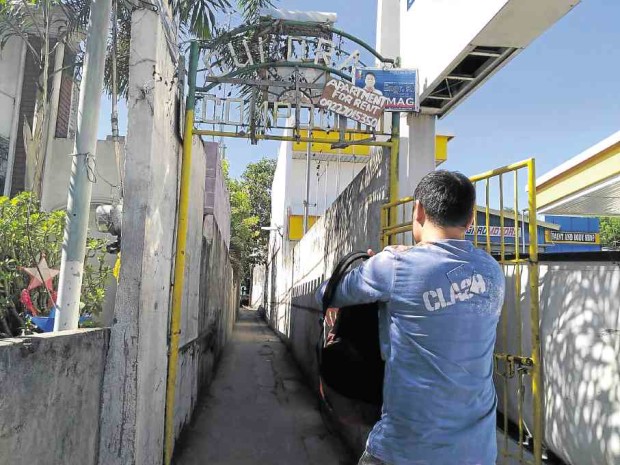“Kick the habit or be kicked out.’’
The 311 residents of Gundran Compound in Barangay Putatan, Muntinlupa City, made their rule sound so simple.
But it’s actually not. To become a government-certified “drug-free community,” the neighborhood of 28 homes underwent a process that started in April this year and was declared a success only last week.
It involved a census, some paperwork, a dose of mutual trust, a dash of self-policing, and a tacit understanding that those who refuse to cooperate should just pack their bags and leave.
The results gave Chris Matias, 28, some peace of mind. “This is good news for us. There won’t be any more trouble, especially from outsiders,’’ she said, as she pointed to a sticker posted on her house that read: “This is a drug-free home (Ang tahanang ito ay malaya sa droga).”
The Dangerous Drugs Board (DDB) and the Department of the Interior and Local Government (DILG) declared Gundran Compound drug-free on Nov. 16. It means there are no more drug users or pushers among the residents, as far as these two agencies are concerned.
The city government, meanwhile, proudly cited Gundran as the latest accomplishment of the campaign dubbed “Crusada,” which stands for Community-based Response: Unified Strategies Against Drug Abuse.
One per barangay
Florocito Ragudo, director of the local Drug Abuse Prevention and Control Office, said Crusada, which was launched in 2003, aims to establish at least one drug-free community per barangay in Muntinlupa City.
“We make sure that the pilot projects would be doable and achievable. If one community can do it, others surely can,” Ragudo told the Inquirer in an interview last week.
Located along National Highway and next to a gated subdivision, Gundran is a mix of low- and middle-income residents living in bungalows or multilevel houses. One of the taller structures currently has a banner on the third floor congratulating a resident for passing the recent civil engineering board exams.
Crusada teams
Ragudo noted that although Gundran is relatively small, making it drug-free was no easy task. It involved up to “10 steps” which were monitored by DDB, DILG and the Philippine Drug Enforcement Agency (PDEA):
Creation of Crusada assessment team composed of city and barangay officers, the police and community leader
Signing of a memorandum of agreement among members of Crusada team
Conducting interviews and discussions in the community concerning the drug problem
Creation of support task groups from the adult male and female population, and also from the youth
Mapping and identification of residents
Identification of suspected “drug personalities”
Posting “drug-free” stickers on homes with no drug personality residing
Home visitation of suspected drug personalities
Certification from Crusada assessment team that the community is drug-free
Hoisting of a “drug-free community” billboard, witnessed by DDB, PDEA, local government officials, and the police
In Gundran, the process began with the creation of the Crusada assessment team in April. “What is good here is that we have the community members monitoring themselves,” Ragudo added.
Hardest part
The longest phase involved the mapping and identification of drug personalities, which was completed in October. Residents were asked to fill out a form asking for information such as their previous address, type of occupancy (homeowner, guest or tenant), education, civil status, religion, name of spouse and dependents (and their own educational attainment), birthday, etc.
“We had a hard time persuading people to accomplish the forms because they think the information they provide would be used against them. I assured them that if they are not hiding anything illegal, they should not be afraid,” Ragudo said.
Rene Rivera, president of the residents’ association, said many of them initially didn’t want to participate, thinking they would just be used by politicians in the next elections.
“This is not about politics. This is for us, so that we don’t have to be afraid that the police would come knocking on our doors one night,” the 63-year-old Rivera recalled telling the cynics.
Step No. 11?
But something else happened that was not exactly spelled out in the 10-step process. Somewhere along the way, word spread that there were two suspected drug users renting a room in one of the houses, Rivera said.
“The owners of the place, fearing they would be branded as coddlers [of drug users], compelled the two tenants to leave the community. I could not talk to them directly; I let the owners deal with them because they were the ones who would know if they were indeed using drugs,’’ he said.
The two were gone by October, according to Ragudo.
Rivera recalled moving to Gundran in 1972, when it was still a hilly grassland that provided much cover for outsiders having “pot sessions.”
“Back then, drug users had many entry points; they could easily go in and out,” he said. “But now, there’s only one way here: If you do illegal drugs, you will surely be caught.”
Since the Crusada program started in April, there has been no drug-related disturbances or arrests on Gundran Compound, according to the Muntinlupa police chief, Senior Supt. Nicolas Salvador. Before the campaign, the police were monitoring at least 10 drug personalities in the area.
“This should be a good example for other communities, as clearing barangays of illegal drugs is difficult without the people helping the police,” Salvador said.
A sticker declares a house in Gundran Compound safe from the drug menace, under the Muntinlupa
City government’s “Crusada” campaign.


